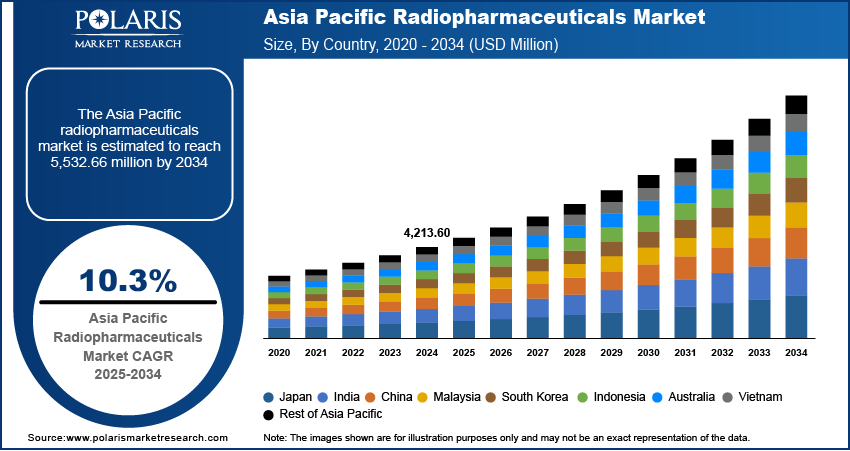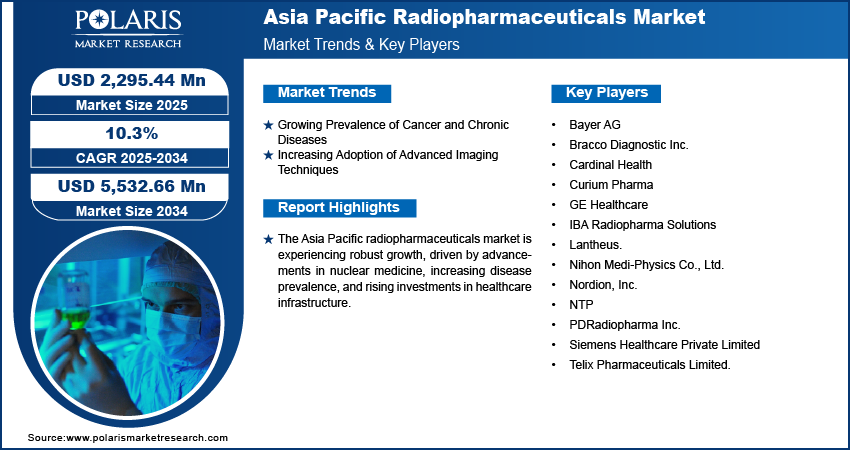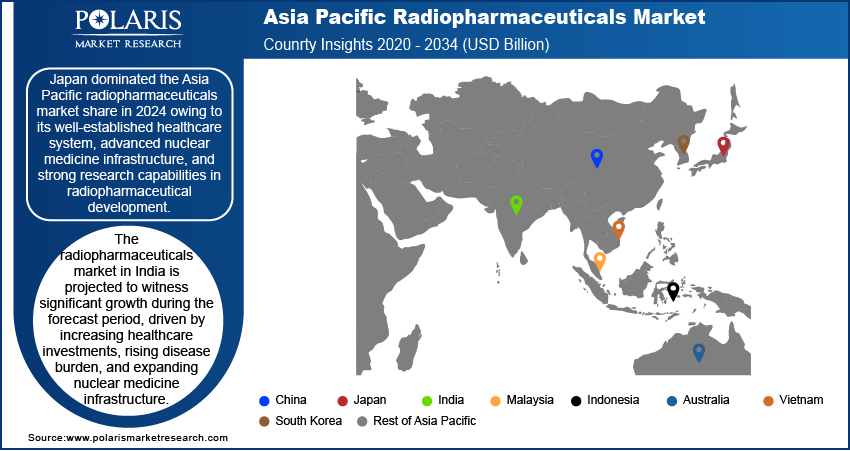
Asia Pacific Radiopharmaceuticals Market Size, Share, Trends, Industry Analysis Report: By Type (Diagnostic and Therapeutic), Application, End Use, and Countries (China, Japan, India, Malaysia, South Korea, Indonesia, Australia, Vietnam, and Rest of Asia Pacific) – Market Forecast, 2025–2034
- Published Date:Apr-2025
- Pages: 129
- Format: PDF
- Report ID: PM5462
- Base Year: 2024
- Historical Data: 2020-2023
Asia Pacific Radiopharmaceuticals Market Overview
The Asia Pacific radiopharmaceuticals market size was valued at USD 2,086.31 million in 2024. It is expected to grow from USD 2,295.44 million in 2025 to USD 5,532.66 million by 2034, at a CAGR of 10.3% during 2025–2034.
Radiopharmaceuticals are radioactive compounds used in medical imaging and therapy to diagnose and treat various diseases, particularly cancer and neurological disorders. The rising healthcare investments in emerging economies drive the Asia Pacific radiopharmaceuticals market growth. Governments and private entities across countries such as India, China, and Southeast Asian nations are allocating substantial resources to improve medical infrastructure, expand nuclear medicine facilities, and improve diagnostic capabilities. An October 2023 report by the NCBI indicated that the union budget allocated USD 889.56 billion to the health sector in India. Additionally, the increasing prevalence of chronic diseases, coupled with a growing aging population, is further boosting the demand for advanced imaging solutions. According to an October 2023 report by the Indian Council of Medical Research, the prevalence of diabetes in India is 101 million. Thus, the rising prevalence of such diseases boosts the Asia Pacific radiopharmaceuticals market development.

To Understand More About this Research: Request a Free Sample Report
Expanding research and development activities in radiopharmaceuticals are propelling innovation and broadening their clinical applications. Academic institutions, research centers, and pharmaceutical companies are actively engaged in developing novel radioisotopes and improving production techniques to improve diagnostic accuracy and therapeutic efficacy. Technological advancements in radiolabeling, coupled with collaborations between industry players and healthcare providers, are accelerating the introduction of next-generation radiopharmaceuticals. In March 2021, BWXT Medical and Global Medical Solutions (GMS) collaborated to produce and distribute radioisotopes and radiopharmaceuticals in Asia Pacific. The JV aims to replicate BWXT’s Tc-99m operations in Asia, improving regional supply chain stability and access. The focus on innovation is improving patient outcomes and also driving the Asia Pacific radiopharmaceuticals market growth by expanding the scope of nuclear medicine in precision diagnostics and targeted therapy.
Asia Pacific Radiopharmaceuticals Market Dynamics
Growing Prevalence of Chronic Diseases
The rising prevalence of chronic diseases, such as cancer, cardiovascular disorders, and neurological diseases, is attributed to the increasing aging population and lifestyle-related risk factors. In 2023, the Indian Council of Medical Research (ICMR) estimated that the number of cancer cases in India surpassed 1.4 million, highlighting the need for advanced diagnostics and treatment solutions due to the increasing disease burden. Healthcare systems are increasingly integrating nuclear medicine to improve patient outcomes. Radiopharmaceuticals play an essential role in early disease detection, allowing accurate diagnosis and personalized treatment planning. Hence, the increasing incidence of chronic conditions has boosted the demand for precise imaging and targeted treatment options, fueling the Asia Pacific radiopharmaceuticals market opportunities.
Increasing Adoption of Advanced Imaging Techniques
Innovations in molecular imaging, such as positron emission tomography (PET) and single-photon emission computed tomography (SPECT), are improving disease detection at an early stage by improving diagnostic accuracy and efficiency. These techniques rely on radiopharmaceuticals to provide detailed functional and metabolic insights, allowing more precise clinical decision making. The demand for high-quality radiotracers and imaging agents continues to rise as healthcare providers prioritize advanced diagnostic solutions. Industry collaborations are emerging to meet this growing demand while advancing technological capabilities. For instance, in January 2021, ARTMS Inc. and Telix Pharmaceuticals collaborated to produce Telix’s prostate cancer imaging product, TLX591-CDx, using ARTMS’ Quantum Irradiation System (QIS). The collaboration demonstrated high-yield, stable production of Gallium-68, improving access to advanced prostate cancer diagnostics via PET imaging globally. This rising adoption of advanced imaging technologies is propelling innovation, increasing procedural volumes, and improving access to nuclear medicine across the region, which boosts the Asia Pacific radiopharmaceuticals market development.

Asia Pacific Radiopharmaceuticals Market Segment Insights
Asia Pacific Radiopharmaceuticals Market Assessment by Type Outlook
The Asia Pacific radiopharmaceuticals market segmentation, based on type, includes diagnostic and therapeutic. The diagnostic segment dominated the Asia Pacific radiopharmaceuticals market share in 2024 due to the increasing reliance on nuclear imaging for early disease detection and precise diagnosis. Positron emission tomography (PET) and single-photon emission computed tomography (SPECT) imaging techniques are widely utilized for diagnosing cancer, cardiovascular diseases, and neurological disorders, driving demand for radiotracers. The rising prevalence of chronic diseases, coupled with growing awareness among healthcare professionals regarding the benefits of molecular imaging, has further accelerated the adoption of diagnostic radiopharmaceuticals. Additionally, advancements in imaging technology and the expansion of medical imaging facilities across the region have strengthened the segment’s market position.
Asia Pacific Radiopharmaceuticals Market Evaluation by End Use Outlook
The Asia Pacific radiopharmaceuticals market, based on end use, is segmented into hospitals and clinics, medical imaging centers, and others. The hospitals and clinics segment is expected to witness the fastest market growth during the forecast period, driven by increasing investments in healthcare infrastructure and nuclear medicine facilities. Hospitals and specialized clinics are integrating advanced imaging modalities to improve diagnostic accuracy and patient management. The growing emphasis on personalized medicine and targeted therapies has further increased the adoption of radiopharmaceuticals in hospital settings for both diagnostic and therapeutic applications. Additionally, government initiatives aimed at expanding healthcare access and equipping hospitals with advanced medical technologies are supporting the segment’s rapid growth, making hospitals and clinics the primary end users of radiopharmaceuticals.

Asia Pacific Radiopharmaceuticals Market Outlook by Country
By country, the report provides the Asia Pacific radiopharmaceuticals market insights into China, Japan, India, Malaysia, South Korea, Indonesia, Australia, Vietnam, and the Rest of Asia Pacific. Japan dominated the Asia Pacific radiopharmaceuticals market revenue in 2024 owing to its well-established healthcare system, advanced nuclear medicine infrastructure, and strong research capabilities in radiopharmaceutical development. The country has a high adoption rate of molecular imaging technologies, with a considerable number of PET and SPECT scanners deployed across medical facilitiesAccording to an April 2024 report by the NCBI, the number of PET centers in Japan increased from 389 in 2022 to 412. Additionally, the presence of leading pharmaceutical and radiopharmaceutical manufacturers, coupled with ongoing innovations in targeted radiotherapy, has contributed to Japan’s market leadership. In December 2023, Accuray Incorporated launched the VitalHold package for Radixact Systems in Japan, allowing surface-guided radiation therapy (SGRT). This feature supports deep inspiration breath hold (DIBH) treatments for breast cancer and markerless patient setup, expanding radiotherapy options with a single device. Favorable regulatory frameworks and strong government support for nuclear medicine research and clinical applications have further reinforced Japan’s dominant position in the regional market.
The radiopharmaceuticals market demand in India is projected to witness significant growth during the forecast period, driven by increasing healthcare investments, a rising disease burden, and expanding nuclear medicine infrastructure. The growing cases of cancer and cardiovascular diseases have heightened the demand for advanced diagnostic and therapeutic solutions, driving the adoption of radiopharmaceuticals. Additionally, the expansion of PET and SPECT imaging centers, along with favorable government initiatives to strengthen nuclear medicine research and production, is accelerating market growth. In January 2021, the Department of Atomic Energy reported that BARC plans to establish India’s first Public-Private Partnership (PPP) Research Reactor to produce nuclear medicines. This initiative aims to make India self-sufficient in radioisotopes for cancer treatment and aligns with the Aatma Nirbhar Bharat initiative, targeting global leadership in the nuclear medicine market. The presence of a large patient population, improving healthcare accessibility, and increasing collaborations between healthcare providers and research institutions are further supporting the Asia Pacific radiopharmaceuticals market expansion.

Asia Pacific Radiopharmaceuticals Market – Key Players & Competitive Analysis Report
The competitive landscape combines regional leaders and country players competing to capture Asia Pacific market share through innovation, strategic alliances, and regional expansion. Players such as GE Healthcare, Cardinal Health, Lantheus Holdings, and others leverage robust R&D capabilities and extensive distribution networks to deliver advanced diagnostic and therapeutic radiopharmaceutical. Asia Pacific radiopharmaceuticals market trends indicate rising demand for solutions, such as novel PET tracers and theranostic agents, reflecting advancements in nuclear medicine and precision healthcare. According to the Asia Pacific radiopharmaceuticals market statistics, the market is projected to grow, driven by increasing cases of cancer, cardiovascular diseases, and neurological disorders. Regional companies capitalize on localized needs by offering cost-effective and tailored radiopharmaceuticals, especially in emerging markets such as India and China, which are anticipated to grow at the fastest CAGR during the forecast period. Asia Pacific radiopharmaceutical's competitive strategy includes mergers and acquisitions, partnerships with medical institutions, and the introduction of innovative radiopharmaceutical products to address the growing awareness and willingness of healthcare providers to invest in advanced diagnostic and therapeutic solutions. These developments highlight the role of technological innovation, market adaptability, and regional investments in driving the Asia Pacific radiopharmaceuticals industry expansion. A few key major players are Bayer AG; Bracco Diagnostic Inc.; Cardinal Health; Curium Pharma; GE Healthcare; IBA Radiopharma Solutions; Lantheus; Nihon Medi-Physics Co., Ltd.; Nordion, Inc.; NTP; PDRadiopharma Inc.; Siemens Healthcare Private Limited; and Telix Pharmaceuticals Limited.
GE HealthCare, an American health technology company based in Chicago, Illinois, operates over 100 countries across the world, with major regional operations in Asian countries, such as China, Japan, and India. The company offers a wide array of products and services, such as medical imaging, electronic medical records, and patient monitoring systems. It serves over one billion patients annually and has an installed base of over 4 million pieces of equipment across its four business segments: imaging, ultrasound, patient care solutions, and pharmaceutical diagnostics. In Asia Pacific, GE HealthCare is poised to expand its presence in the radiopharmaceuticals market. GE HealthCare's strategic focus on neurological disorders (MIND) and its involvement in key care areas align with the growing demand for advanced diagnostic and therapeutic solutions in the region. Furthermore, the company is set to take full control of Nihon Medi-Physics, a Japanese radiopharmaceutical venture, by the end of March 2025, strengthening its precision care strategy in Asia. This acquisition will allow GE HealthCare to leverage Nihon Medi-Physics' expertise and scale to introduce novel products to the Japanese market and beyond.
Bayer AG is a German multinational corporation headquartered in Leverkusen, specializing in pharmaceuticals and biotechnology. Established in 1863, Bayer has evolved into one of the world's largest pharmaceutical companies, with a diverse portfolio that includes prescription medications, consumer health products, agricultural solutions, and biotechnology innovations. The company operates through various divisions, including pharmaceuticals, which focuses on therapeutic areas such as oncology, cardiology, and women's health, as well as crop science, dedicated to agricultural products and solutions. In Asia Pacific, Bayer has expanded its presence, leveraging local partnerships and investments to improve healthcare access and agricultural productivity. The company markets a wide range of products tailored to meet the unique needs of this diverse market, such as innovative radiopharmaceuticals for diagnostic imaging and therapeutic applications. Bayer's commitment to research and development in this area aims to improve patient outcomes by providing advanced diagnostic tools and treatments. This strategic focus aligns with Bayer's broader objective of addressing global health challenges while contributing to sustainable agricultural practices across Asia Pacific.
List of Key Companies in Asia Pacific Radiopharmaceuticals Market
- Bayer AG
- Bracco Diagnostic Inc.
- Cardinal Health
- Curium Pharma
- GE Healthcare
- IBA Radiopharma Solutions
- Lantheus.
- Nihon Medi-Physics Co., Ltd.
- Nordion, Inc.
- NTP
- PDRadiopharma Inc.
- Siemens Healthcare Private Limited
- Telix Pharmaceuticals Limited.
Asia Pacific Radiopharmaceuticals Industry Development
April 2024: RIKEN advanced cancer treatment by producing astatine-211, a radioisotope for targeted therapies. Using innovative methods, RIKEN’s particle accelerators enable efficient production, supporting Japan’s first clinical trial of an astatine-211-based anticancer radiopharmaceutical at Osaka University Hospital.
April 2024: BAMF Health and Nihon Medi-Physics (NMP) conducted the first clinical trial imaging of a patient using NMK89, a novel radiopharmaceutical targeting pancreatic cancer. The trial aims to improve early detection and assess the potential for future targeted therapies.
Asia Pacific Radiopharmaceuticals Market Segmentation
By Type Outlook (Revenue, USD Million, 2020–2034)
- Diagnostic
- Therapeutic
By Application Outlook (Revenue, USD Million, 2020–2034)
- Cancer
- Cardiology
- Others
By End Use Outlook (Revenue, USD Million, 2020–2034)
- Hospitals and Clinics
- Medical Imaging Centers
- Others
By Country Outlook (Revenue, USD Million, 2020–2034)
- Asia Pacific
- China
- Japan
- India
- Malaysia
- South Korea
- Indonesia
- Australia
- Vietnam
- Rest of Asia Pacific
Asia Pacific Radiopharmaceuticals Market Report Scope
|
Report Attributes |
Details |
|
Market Size Value in 2024 |
USD 2,086.31 million |
|
Market Size Value in 2025 |
USD 2,295.44 million |
|
Revenue Forecast by 2034 |
USD 5,532.66 million |
|
CAGR |
10.3% from 2025 to 2034 |
|
Base Year |
2024 |
|
Historical Data |
2020–2023 |
|
Forecast Period |
2025–2034 |
|
Quantitative Units |
Revenue in USD Million and CAGR from 2025 to 2034 |
|
Report Coverage |
Revenue Forecast, Market Competitive Landscape, Growth Factors, and Industry Trends |
|
Segments Covered |
|
|
Regional Scope |
|
|
Competitive Landscape |
|
|
Report Format |
|
|
Customization |
Report customization as per your requirements with respect to countries, regions, and segmentation. |
FAQ's
The market size was valued at USD 2,086.31 million in 2024 and is projected to grow to USD 5,532.66 million by 2034.
The market is projected to register a CAGR of 10.3% during the forecast period.
Japan dominated the market revenue in 2024.
A few of the key players in the market are Bayer AG; Bracco Diagnostic Inc.; Cardinal Health; Curium Pharma; GE Healthcare; IBA Radiopharma Solutions; Lantheus; Nihon Medi-Physics Co., Ltd.; Nordion, Inc.; NTP; PDRadiopharma Inc.; Siemens Healthcare Private Limited; and Telix Pharmaceuticals Limited.
The diagnostic segment dominated the market in 2024.
